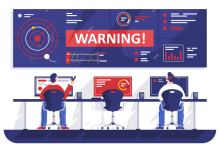
You don’t have to spend much time on a contact center floor before you notice what seems to be an overgrowth of colorful little pieces of paper on each agent’s desk: clusters of sticky notes on agent’s monitors and on their phones reminding them what to do, what to say, or simply to remember to smile. And it’s often not just sticky notes. Binders, laminated sheets, notepad apps—all these makeshift guides that clutter up agents’ workspaces are an agent’s attempts to have at hand all the information they will need to handle every customer’s call. But every time you see an agent put up a sticky note or any such workaround, you should consider it a symptom of a breakdown in your customer service process.
When your customers call your contact center, the process of delivering consistent, accurate and efficient service should be simple. You need to know the customer’s history with your company, understand why they’re calling, and be able to resolve the issue or answer the question in an efficient, timely fashion. After the call, the customer should hang up the phone feeling assured the agent they spoke to is an expert and provided all the answers and solutions they needed. All of that, and without putting the customer on hold.
But we all know that resolving customer issues can be anything but simple, and the agent’s job—despite being a critical component of delivering great customer service—can be stressful, daunting and fraught with ambiguity. To combat this, we give agents software tools, knowledge bases and process documentation—essentially every bit of information they might need to handle every customer and every call type. But asking your agents to search through your knowledge base, read (or more likely, skim) what they believe to be the relevant article, and interpret the best way to proceed is an inefficient system, and likely to result in long handle times and inaccurate answers. Even for a seasoned agent, memorizing every step, especially if your contact center has dozens of complex call types, is extremely difficult and processes often change.
So, your agents try to bridge the gap with workarounds—with these sticky notes, binders, laminated sheets, notepad apps—that clutter up their workspace with various pieces of information. But quickly, this system is no longer scalable. How many sticky notes can one agent have on her desk before they no longer make her any more efficient? And how uniform will your service be overall if every agent makes handwritten notes for what to do in a given situation? As the number of workarounds grows, your agents aren’t sure what to do, service isn’t uniform, your customers’ issues aren’t resolved efficiently, and you’re left wondering why all your investments in people and technology still aren’t improving your metrics.
The Case for Starting with Process
In the past, many managers would attempt to improve struggling contact center metrics by focusing on recruiting and training, hoping to develop agents who are simply better at their jobs. Other managers would start shopping for software tools meant to improve performance and keep agents productive, engaged and motivated. But improving call center metrics and overall customer satisfaction is not just a people issue, nor is it just a technology issue. What many managers have neglected to address is the process of how customer service is going to be delivered every time.
By starting with a clearly defined process, you’ll have a better idea of how many agents and what types of agents you’ll need to handle current call volumes while doing the job correctly, and you can look for technology solutions that reinforce that process. Otherwise, you’re just guessing at how many agents and what technology tools you’ll need. Think of it this way: If you could hire the best managers and the finest agents, but the process for them to deliver great customer service is missing, how likely is it that your customers will be happy with your service? Similarly, if you invested in all the latest and best-in-class technology, but the process that technology was meant to facilitate was poorly defined, what kind of impact would your technology investment have on your metrics?
Are You Really Focused on Your Agents?
We all understand that agents are critical in delivering great customer experiences, so it makes sense that developing ways to keep agents happy with their work has been a focus of recent innovation in the customer service industry. Various technology and gamification tools designed to keep agents happy and engaged are popular options. Still, while these tools might have some impact on agent job satisfaction, they don’t ultimately result in higher customer satisfaction. On the contrary, all the technology and other incentives that contact center managers provide to their agents to make them happier and more effective usually have the opposite effect, complicating the process of helping customers, making the job of the agent more complex, and adding unnecessary stress and confusion to what is already a stressful job. So, instead of being guided through the steps of delivering great customer service, your agents are left unsure of how to proceed, and the path to providing excellent customer service becomes less and less clear.
For example, we’ve all seen painstakingly detailed knowledge bases that are designed to give agents all the information they need to handle any call. If they have access to all the answers they need, accurate and consistent customer service should follow, right? Well, let’s imagine we’re going on a road trip. If we have a map and a destination, theoretically, we have all the information we need to get where we’re going. But there’s a reason no one uses a road atlas anymore: Using a printed map to navigate involves the same process of searching, reading and interpreting that we make our agents use, and it is a process that is error-prone, requires lots of effort and takes the focus away from driving. And what if you take a wrong turn? You have to turn around, go back and find where you made the mistake, and then continue on in what you hope is actually the right direction this time.
But now that we all have turn-by-turn directions on our phones, we no longer make those kinds of mistakes. Instead, at each juncture, our GPS just tells us what to do next and it continually updates to adjust the route so that no matter if we miss our exit or stop for gas, we’ll still be guided to the right destination in the end. It’s the same information that a map provides, but the GPS filters out all the unnecessary information—the mile markers, rest stops and back roads that you don’t actually need to pay attention to—so you don’t have to guess; you just have to steer. That is a clearly defined process, and the result is a journey that is simply more efficient and less stressful.
In the same way, we can make the agent experience better by filtering out all the excess information and by providing specific guidance on what questions to ask, what to say and what to do next, no matter where the conversation goes. Then, at every step of a customer’s interaction, from the initial authentication process to deep into a complicated call, agents feel more supported, more confident and less stressed. After all, agents who can do their jobs effectively, efficiently and confidently are happier employees. And naturally, your customers will appreciate the effectiveness, efficiency and confidence, as well.
The bottom line: Bad customer experiences are often the result of bad process and agents who simply don’t know what to do next. To fix the process—and to get rid of the sticky notes and other workarounds—you need to remove the friction that keeps your agents from following that process, not by giving them any and all information they might need, but by simplifying the process of their job and showing them exactly how to proceed.
Are your agents filling in the gaps in your process with sticky notes? If they are, you don’t have an agent problem or a technology problem—you have a process problem. But fixing it is simple—focus on giving your agents the information they need to handle any customer inquiry at the exact time they need it, and get rid of the sticky notes and other workarounds that are currently filling in the gaps in your process. That’s the fastest path to better metrics, a better customer experience, lower operating expenses and greater control over your contact center performance.





